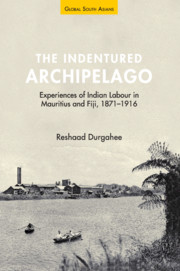Book contents
- Frontmatter
- Dedication
- Contents
- List of Figures and Tables
- Acknowledgements
- List of Abbreviations
- 1 Introduction
- 2 Indentured Spaces: Mauritius
- 3 Indentured Spaces: Fiji
- 4 Subaltern Careering
- 5 Innovation and New Migration Routes
- 6 Conclusion: Space, Agency, Mobility, Geography
- Appendix: Proposed Indian Emigration Routes, 1871–1914
- Glossary
- Bibliography
- Index
2 - Indentured Spaces: Mauritius
Published online by Cambridge University Press: 06 August 2021
- Frontmatter
- Dedication
- Contents
- List of Figures and Tables
- Acknowledgements
- List of Abbreviations
- 1 Introduction
- 2 Indentured Spaces: Mauritius
- 3 Indentured Spaces: Fiji
- 4 Subaltern Careering
- 5 Innovation and New Migration Routes
- 6 Conclusion: Space, Agency, Mobility, Geography
- Appendix: Proposed Indian Emigration Routes, 1871–1914
- Glossary
- Bibliography
- Index
Summary
The Indentured Geography of Mauritius
Mauritius had been the test case for the use of indentured labour during the 1820s and 1830s. By the late 1870s, smaller, but no less significant, numbers of immigrants were arriving in the colony compared to previous decades. Indenture by this point had already been operating in Mauritius for approximately 40 to 50 years. Literature on Indian indenture to Mauritius has therefore concentrated on the first half of the indenture period in the colony (1834 to the 1870s). It is, however, misleading to concentrate only on the earlier period. To do so skews the perception of what life was like for an Indian immigrant in Mauritius, for as the indenture system became more regulated and communication between Mauritius and India (remittances, letters, re-migration) increased in intensity, life for an Indian immigrant in Mauritius in the late nineteenth century or early twentieth century was not the same as it was for his or her predecessor in the 1840s. The deadly epidemics on the island during the mid-nineteenth century, including the catastrophic ‘Mauritius Fever’, had resulted in the enforcement of much more stringent regulations regarding sanitation and housing of labourers, which will be explored in this chapter.
The latter half of the indenture period in Mauritius brings to light evidence of individual and group agency, notions of subaltern careering, elite careering, trans-colonial networks, increased regulation and cooperation (but also dispute) with other indenture-importing colonies and the eventual integration of the Indian immigrant population into Mauritian society. The turn of the century was also a pivotal time in the galvanising of an Indo-Mauritian identity. The cyclone of 1892 devastated the colony, killing 1,100 people, wounding 2,000 and leaving 50,000 homeless. Meanwhile, the plague outbreak in the late 1890s and early 1900s tested the rigour of the island's sanitation and health policies.
The upward social mobility of Indian immigrants also became increasingly apparent during this period as morcellement (parcelling out of sugar estate land to Indians) gathered pace. Though Allen states that this process began in the 1860s, it reached its peak post-1880. By the turn of the century, one-third of the land under cane cultivation was in Indo-Mauritian hands as estate owners centralised their landholdings and disposed of marginal land.
- Type
- Chapter
- Information
- The Indentured ArchipelagoExperiences of Indian Labour in Mauritius and Fiji, 1871–1916, pp. 25 - 97Publisher: Cambridge University PressPrint publication year: 2021

